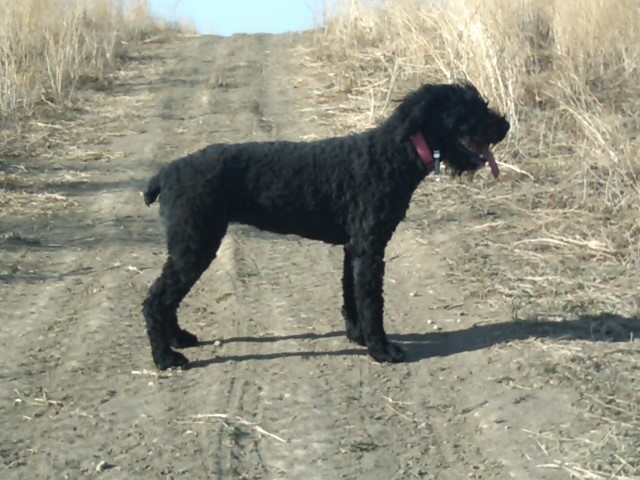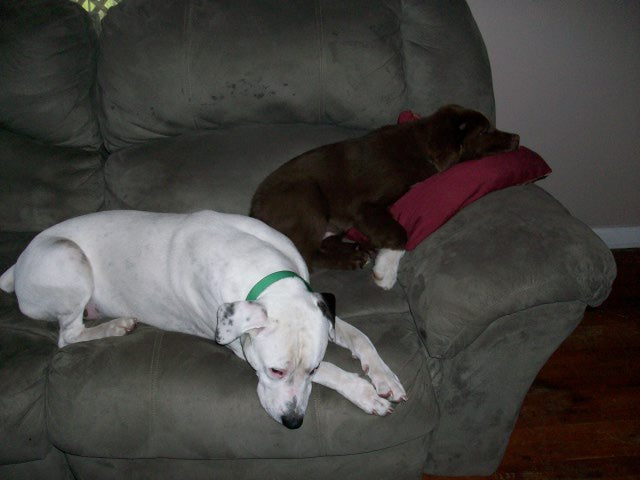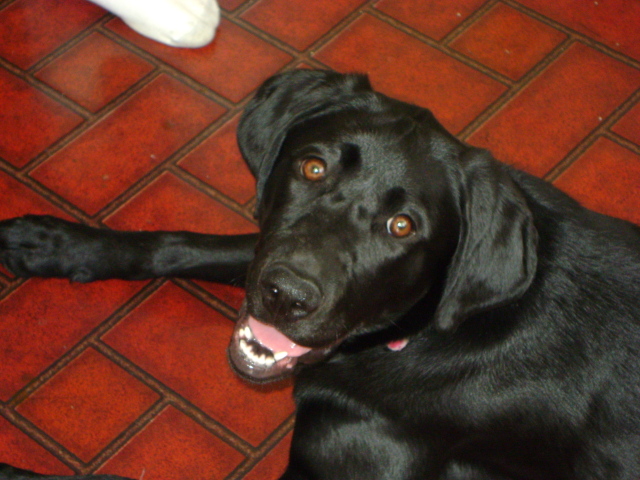QuestionI adopted a Jack Russell from the humane society in February knowing full well of the quirks that he might have. We've been going to obedience school and he seems to enjoy learning. There's one major issue that we have been having with him. He keeps bolting out the door and refuses to come when called. About all he will do is stop and look back for about a minute and keep going. I've tried to turn and run the other way and he still doesn't respond. Is there anything that we could do to get him trained for off leash? Even how to get him to come would be nice. I worry that someone will take him or he'll get hit by a car.
AnswerYou're probably seeing why this dog ended up in the shelter! These dogs are terrific roamers (I had one for years!) BUT they are also extremely intelligent (although VERY stubborn!) and train magnificently! You need to work on your recall in various ways, here's how to train this behavior in two different ways:
FIRST: Create a unique recall word (do NOT use "come" as this has most likely been reduced to meaningless jabber in the dog's repertory!) I use "Presto" but you can invent your own.
NEXT: Stand in front of the dog with the dog on leash; step toward him very slowly until he backs up and sits down; say "Presto" and pop hot dog bit in his mouth. Walk backward, dog will follow and will most likely sit immediately (but if he doesn't repeat by stepping toward him until he does), say "Presto", pop treat in mouth; walk backward or to the side, dog should (at third trial) come to sit in front of you with no effort from you, say "Presto" jackpot (several pieces) in his mouth: end event. REPEAT this (three times each trial) randomly over the course of every single day until it's clear the dog no longer requires any restraint and will HAPPILY (even GLEEFULLY lol) come to SIT in front of you for "Presto" and ALWAYS extra fine juicy food reward. Once dog is performing ten out of ten times, start offering "Presto" command from another room, and jackpot every single time the dog comes to sit in front of you.
Chain this training with a "round robin recall" in a safely enclosed outdoor location with family or friends: squat (or sit) in a circle with dog in the middle. Each person has special baggy of treats (diced tiny); you can initiate this "game" with a large ball by tossing it to one another while the person RECEIVING the ball yells "PRESTO!" if the dog won't participate at first, but this is RARE. MOST dogs, call name, eye contact, "PRESTO!", hold out treat, will willingly and readily begin to go from one person to the other in this circle, EACH TIME getting a special treat. Keep this game short but sweet (a couple of minutes) and repeat it once a day; as the dog begins to anticipate the recall (watches body language of circled people), WAIT for him to SIT before giving treat: he may be confused at first, raise treat over his head so he has to look up, his butt will hit the ground, pop treat in mouth (DO NOT command "sit".)
Between these two exercises, religiously done over the course of several weeks, your dog will acquire a STRONG conditioned response to the word "PRESTO" which involves his sitting in front of your for treat. Now you can take this behavior outdoors on very long extending leash or clothesline (NOT off lead even in enclosed area, we don't want the dog to fail.) Walk or trot backward away from the dog, as dog turns to come toward you scoot down, open your arms, say "PRESTO", dog comes to sit in front of you, jackpot; get up and walk normally for a few minutes, then repeat. Try to lengthen the distance between you and the dog slowly. Once your dog is responding EVERY time, go to safely enclosed area. Get dog's attention for the first few times (by whistling or clapping your hands) then scoot down, open arms, "PRESTO" and get ready to jackpot reward.
The recall is extremely difficult to put into place for dogs that have been taught incorrectly by former owners and VERY difficult to TRUST in a situation where the dog is clearly free and at large (very self rewarding situation for the dog.) Do NOT test it; train it religiously, for weeks and months, until the dog is SOLID and THEN you will most likely have a secure recall even in situations such as when a dog has bolted out.
Until then, set the dog up at the front door. He has to experience something totally different when he bolts out. Put extremely long (doubled) training leash on him and let him roam the house freely wearing it for a short while (half an hour) or until it's obvious he's not connecting this lightweight item with restraint. You must have a way of stopping him (not allowing him to actually GO anywhere) once he bolts. Have someone on the other side of the door with a hose, fireman's nozzle set high, ready to "fire": accidentally-on-purpose crack the front door, have a cue for the "fireman" ("READY") as dog darts out, blast dog with water, reel him back in using long leash, make a BIG DEAL of his coming back into the house (tons of praise, pats, a cookie, etc.) Wait a day or two during which time you will randomly attach this long lightweight leash but DO NOTHING with it and remove it a half hour to an hour later; then set the dog up again. See how he responds the next time (when he has no clearcut connection between wearing this lightweight long leash and being set up or controlled in any way). If by the third effort he shows NO hesitance to bolting out that door, you'll need a professional to use an aversive. You can find a behaviorist at the following site:
http://www.animalbehavior.org/ABSAppliedBehavior/caab-directory
My guess is, he will learn that this formerly rewarding behavior (running through the front door) is NO LONGER so much fun: when a dog runs in this way, people CHASE him (calling his name) and it becomes a GAME to the dog. Sometimes it's as easy as running back into the house and slamming the door! Dogs often respond by frantically trying to get BACK IN when the entire family disappears through the door in this manner, BUT a dog that has learned how much FUN it is to be out there on his own may not respond to that easy trick. Conditioning a startle response when HE chooses to bolt by making the experience SOMETHING TOTALLY DIFFERENT (not painful, just not what he expects) often works.

 I was riding my bicycle when my 1yr old Bouvier bit my leg
Question
Pup
Hello, I have a 1yr old intact Bouvier bit
I was riding my bicycle when my 1yr old Bouvier bit my leg
Question
Pup
Hello, I have a 1yr old intact Bouvier bit
 American Bulldog aggression
Question
Buddy and Rez
I have a 2 year old Ameri
American Bulldog aggression
Question
Buddy and Rez
I have a 2 year old Ameri
 Black lab - 1 yr
QuestionSheba
QUESTION: My lab loves to bite her
Black lab - 1 yr
QuestionSheba
QUESTION: My lab loves to bite her
 Post bladder surgery potty training for INDOORS!
QuestionTiki
QUESTION: Dear Dr. Connor,
My 10 ye
Post bladder surgery potty training for INDOORS!
QuestionTiki
QUESTION: Dear Dr. Connor,
My 10 ye
 Agressive 1 yr old mini goldendoodle
Question
our millie
My husband and I got our min
Agressive 1 yr old mini goldendoodle
Question
our millie
My husband and I got our min